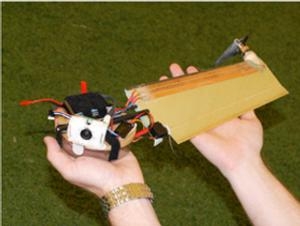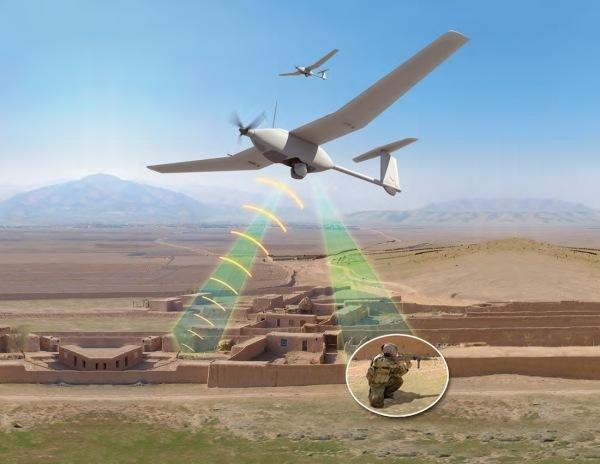Tiny Samarai, Ruggedized Stalker Presented By Lockheed
Martin
A beefed-up long-endurance UAS and an aircraft inspired by a
maple seed are among the unmanned systems being displayed by
Lockheed Martin at the AUVSI's Unmanned Systems North America show
in Washington, DC this week.
Image Courtesy Lockheed Martin

Weighing less than half a pound, Lockheed Martin's Samarai
handheld vehicle flew publicly for the first time Tuesday at the
Association for Unmanned Vehicle Systems International conference.
Samarai demonstrated vertical takeoff and landing, stable hover,
and on-board video streaming. While the aircraft flew a series of
flights in the roughly 40 foot test area, it streamed live video
from a camera that rotated around its center providing a 360 degree
view without a gimbal.
"Our team has taken the basic shape and design of the naturally
aerodynamic maple seed and harnessed it with flight controls and
avionics," said Kingsley Fregene, principal investigator for
Samarai at Lockheed Martin's Advanced Technology Laboratories.
"We've learned a great deal about biologically inspired vehicles
that we can apply across the laboratory, including a better
understanding of micro-robots and the devices that control their
movement."
Samarai is mechanically simple with only two moving parts.
Because its 16 inches long and weighs less than half a pound, an
operator can easily carry the vehicle in a backpack and launch it
from the ground or like a boomerang. The design is scalable to meet
different missions, including surveillance and reconnaissance and
payload delivery.
Lockheed Martin tested the first 3-D printed Samarai last week.
The vehicle was produced by "printing" successive small layers of
plastic to create a single form. The printer eliminates expensive
production costs, allowing engineers to quickly and affordably
produce Samarai tailored to specific missions.
Image Courtesy Lockheed Martin

At the other end of the spectrum, the company's ruggedized
version of the Stalker Unmanned Air System (UAS), called the
Stalker eXtreme Endurance (XE) UAS, quadruples Stalker's flight
endurance to eight-plus hours without impacting the mobility of the
unmanned system or the flexibility of its payload capabilities,
according to Lockheed. "Missions requiring real time eyes-on a
situation for extended periods of time, like border patrol,
pipeline surveillance and special operations can now be conducted
by a small UAS versus a larger, more costly system," said Tom
Koonce, Lockheed Martin's Stalker program manager. 'The convenience
and lower cost of a small UAS combined with extended endurance is a
true game-changer."
The Stalker XE system is powered by Ultra Electronics'
pioneering hybrid energy source using a propane fuel cell with a
small, conventional lithium polymer battery to handle power peaks.
This long-endurance fuel cell technology was developed through an
innovative Defense Advanced Research Projects Agency (DARPA)
sponsored effort led by Lockheed Martin and Adaptive Materials
Incorporated (now a division of Ultra Electronics Holdings, plc).
The DARPA project culminated with a rigorous flight test program
including numerous back-to-back, long endurance intelligence,
surveillance and reconnaissance high altitude and high wind flights
proving that the Stalker UAS met or exceeded all technical and
performance milestones.
The complete Stalker XE system includes two aircraft, fuel
cells, command and control ground station, support equipment, and
small propane fuel storage tank. The standard air vehicle sensor is
a modular dual daylight and night-time imager that allows
persistent surveillance during the visual/thermal transition from
day to night.
 ANN's Daily Aero-Linx (06.29.25)
ANN's Daily Aero-Linx (06.29.25) ANN's Daily Aero-Term (06.29.25): Gross Navigation Error (GNE)
ANN's Daily Aero-Term (06.29.25): Gross Navigation Error (GNE) Classic Aero-TV: Anticipating Futurespace - Blue Origin Visits Airventure 2017
Classic Aero-TV: Anticipating Futurespace - Blue Origin Visits Airventure 2017 NTSB Final Report: Cirrus SR22
NTSB Final Report: Cirrus SR22 Airborne Affordable Flyers 06.26.25: PA18 Upgrades, Delta Force, Rhinebeck
Airborne Affordable Flyers 06.26.25: PA18 Upgrades, Delta Force, Rhinebeck




